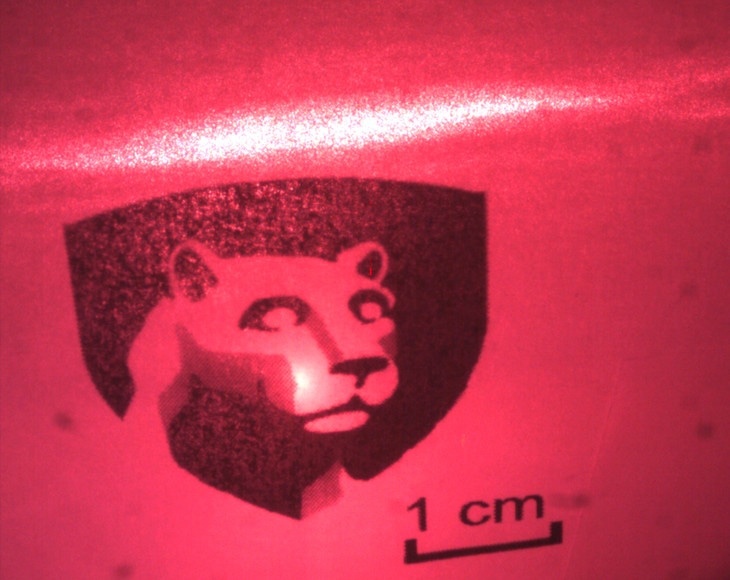Nov 21 2017
From the year 1962, when semiconductor diode lasers were invented, they have dramatically transformed communications and enabled storage and retrieval of information in DVDs, CDs, and Blu-ray disks.
The diode lasers are made of inorganic semiconductors develop in complex high vacuum systems. At present, scientists from Penn State and Princeton University have taken a huge leap toward developing a diode laser by using a hybrid organic-inorganic material that can be deposited from a solution on a laboratory benchtop.
 A red laser beam shines on a card bearing a replica of Penn State’s academic logo. CREDIT: Yufei Jia, Penn State.
A red laser beam shines on a card bearing a replica of Penn State’s academic logo. CREDIT: Yufei Jia, Penn State.
It’s usually not a big leap to turn a light emitting diode into a laser, you essentially just add mirrors and drive it harder. Once organic light-emitting diodes were invented 30 years ago, everybody thought that as soon as we had relatively efficient OLEDs, that an organic laser diode would soon follow.
Chris Giebink, assistant professor of electrical engineering from Penn State.
The organic diode lasers transpired to be very difficult to develop.
An organic laser diode could be highly beneficial. As organic semiconductors are comparatively flexible and soft, organic lasers can be included into innovative form factors not probable for inorganic lasers. In contrast to inorganic semiconductor lasers that are comparatively restricted in terms of the wavelengths (or colors) of light emitted by them, organic lasers have the ability to produce any wavelength that a chemist desires to produce in the lab by customizing the structure of the organic molecules. This potential to be customized can be very helpful in uses from medical diagnostics to environmental sensing.
Although none have been successful in developing an organic laser diode thus far, the solution might be the use of related materials, that is, organic/inorganic perovskites, which have gain considerable attention in the field of research in the recent past. According to Giebink, this hybrid material has been hitherto accountable for a drastic increase in the efficacy of photovoltaics.
Perovskite are relatively common minerals and have a similar cubic crystal structure. Paradoxically one reason for the exceptional functionality of hybrid perovskite materials in solar cells is that they are excellent emitters of light. Hence, they are of interest for use in lasers and LEDs. The material investigated by Giebink and his collaborators is formed of an inorganic perovskite sublattice with comparatively big organic molecules trapped in the middle.
The ultimate goal is to make an electrically driven perovskite laser diode, that would be a game changer. It is fairly easy to make the perovskite material lase by optical pumping, that is, by shining another laser on it. However, this has only worked for very short pulses due to a poorly understood phenomenon we call lasing death. Getting it to go continuously is a key step toward an eventual electrically driven device. What we found in this recent study is a curious quirk. We can avoid lasing death entirely just by lowering the temperature of the material a little bit to induce a partial phase transition.
Chris Giebink, assistant professor of electrical engineering from Penn State.
In a paper reported online in the Nature Photonics journal on (November 20, 2017), Giebink and collaborators report on the first “Continuous-wave lasing in an organic-inorganic lead halide perovskite semiconductor.”
When we lowered the temperature below the phase transition, we were surprised to find that the material initially emitted light from the low temperature phase, but then changed over within 100 nanoseconds and began lasing from the high-temperature phase — for over an hour, it turned out that as the material heated up, although most of the material remained in the low-temperature phase, small pockets of the high-temperature phase formed, and that was where the lasing was coming from.
Yufei Jia, lead author of the study and a graduate student in Giebink’s lab.
Certain inorganic lasers include narrow regions known as quantum wells in which charge carriers can be confined when the holes and electrons fall into the wells. The laser intensity is based on the number of charge carriers that can be loaded into the quantum wells. In the perovskite material, the positioning of the high-temperature-phase inclusions within the low-temperature bulk has been found to simulate the quantum wells and might have a significant role in activating continuous lasing.
“The jury is still out on this explanation,” stated Giebink. “It may be something more subtle.”
However, these outcomes indicate a chance to develop a material with the built-in characteristics of this mixed-phase arrangement, yet without the need to actually cool the material to a lower temperature. This paper reports on a couple of concepts for the way those materials can be developed. The next huge step is to leave behind optical pumping by using an external laser and adopt a perovskite laser diode that can be directly powered by electrical current.
“If we can solve the electrical pumping problem, perovskite lasers could turn into a technology with real commercial value,” noted Giebink.
Apart from Giebink and Jia, other contributors to the paper include Alex Grede, a graduate student in Giebink’s lab, and Princeton assistant professor Barry Rand and his graduate student Ross Kerner.
This study was supported by the Air Force Office of Scientific Research, the National Science Foundation, DARPA, and the Office of Naval Research.